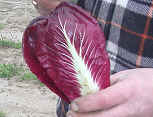The history of Radicchio Rosso di Treviso is inextricably bound up with the evolution of rural traditions in its zone of production. Forcing techniques were first applied to the growing of Radicchio (a strain of chicory) around the middle of the sixteenth century. One source of historical reference is the local culinary tradition where Radicchio is an important ingredient. The traditional process that this leafy vegetable undergoes may be divided into the several stages listed below:
Preforcing In this first phase, the plants are picked and their outermost leaves removed. The soil clinging to the roots is cleaned
away.
Forcing-blanching This is an indispensable operation which exalts the organoleptic and aesthetic qualities of late-season Radicchio, and hence raises its market appeal. The roots are replanted in a dark environment where they produce new leaves. The absence of light, however, deprives the plant of all or almost all its chlorophyll pigments, and this brings out the intense red of the leaf which also loses its fibrous texture and acquires a crunchy consistency and pleasantly bitter taste.
Trimming The next phase consists in untying the tufts or removing them from their
boxes. Leaves that have deteriorated or are not up to standard are stripped away until a sprout with the desired properties
remains.

The tap root is trimmed and scraped until its length is proportionate to the tuft of leaves above. This final phase must be carried out just before the vegetable is eaten. Once the operation is complete, the Radicchio is placed in capacious containers where it is washed in running water before packaging.
Radicchio Rosso di Treviso is a peculiar vegetable whose serrated leaves grow straight upwards to a height of 20 centimetres. The tips of the leaves tend to fold in towards each other and enclose the tuft from above. After the forcing operation, the ribs of the leaf are extremely white, while the leaf itself is smooth and carmine red. The final result is a leaf with a faintly bitter taste and a crunchy texture. The production area encompasses many town districts in the provinces of Treviso, Padua and Venice.